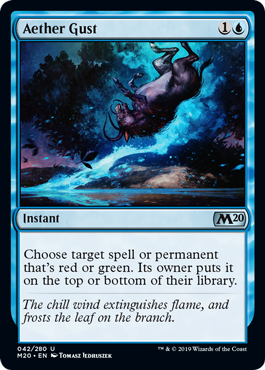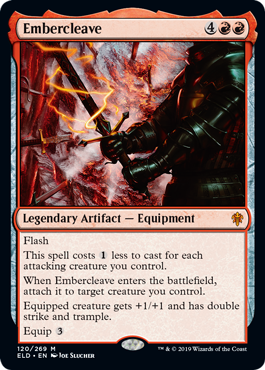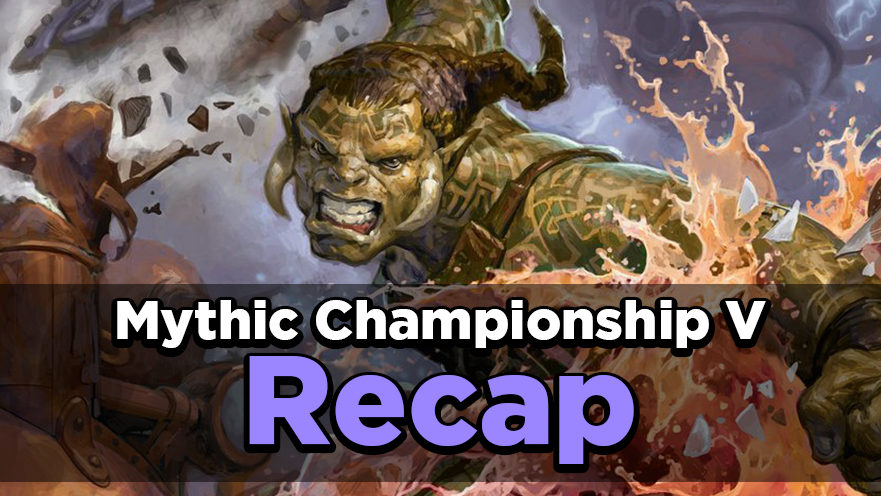This weekend saw 68 of the world’s best Magic players put their Standard skills to the test in the most high-stakes arena possible. Mythic Championship V was the definitive test of the early Throne of Eldraine metagame – and with Wizards announcing early B&R changes, it was likely also the final test.
Many Standard players were begging for that B&R after seeing the number of Golos Field lists registered for MCV. But this was not a simple storyline of a Golos victory lap before it catches the ban hammer! In an event dominated by similar green midrange decks, a handful of key cards emerged to unlock that warped metagame.
I. Field of the Dead

OK, so the story of MCV did not end up being The Tale of Golos Field. But I could not have described the meta of this tournament if I did not mention a deck that represented 40% of Day 1 and Day 2 competition. Field of the Dead was the super-massive black hole warping the format around itself. The land was powerful enough to warrant an emergency ban after the tournament, despite only putting a single pilot through to the Top 8.
The Golos Field deck was poised for success in a metagame where aggro decks struggled with Oko, Thief of Crowns and instant speed interaction had been driven off by Teferi, Time Raveler. In the midrange brawls that ensue, it’s tough to outvalue a ramp deck that also generates hordes of zombie tokens from its ramp spells thanks to Field of the Dead. With Hydroid Krasis and Golos activations to keep the cards flowing, it’s easy to see why this strategy had such a huge impact on MCV.
II. Nissa, Who Shakes the World/Oko, Thief of Crowns

As I mentioned, the ultra-powerful Planeswalkers we’ve seen in the last couple of sets may have done even more to shape the meta than the Field deck. Nissa and Oko in particular are uniquely flexible and hard-to-blunt threats. The UGx decks built around this deadly pair ended up dominating the tournament, perched in the sweet spot where they could pressure Bant Golos while overpowering aggro decks. In this strategy, Nissa and Oko end up having very similar effects on the game, so I’ve lumped them together here.
Both Planeswalkers start with solid loyalty and do their best work while ticking up, using abilities which affect the battlefield immediately. This makes it very hard to kill them with creatures, especially if they come down on or ahead of curve. The battlefield presence generated also means aggro decks ignoring them and going face is also a tricky plan to execute. In addition to generating free value turn-on-turn, both of these ’walkers power up a suite of other excellent cards – Oko’s food enhances Gilded Goose and Wicked Wolf, while Nissa’s absurd mana-generation breaks the X-costed hydras.

“Turn 3 Nissa, make a 3/3 blocker” was already one of the best lines of play in pre-rotation Standard, and Turn 2 Oko feels close to the same thing. Though he won’t end midrange mirrors quite as fast, the Eldraine planeswalker has made himself the 2nd card in emergency-ban discussions. The combination of gaining life, making 3/3 blockers, and “blanking” powerful threats/engine cards just solves too many problems by itself.
In Oko’s fey presence, creatures must have haste or ETB value, and the preferred threats are lands and Planeswalkers – card types he can’t turn into elk. The trickster Planeswalker may have dodged getting banned alongside Field of the Dead this week, but Wizards definitely have their eyes on him and the UG ramp strategies moving forward. If the return of archetypes like Esper Control and UGx Flash can’t keep Oko under control, there will be no second reprieve.
III. Disdainful Stroke

With so much of the field choosing to play UG ramp decks, there was an increased focus on the small choices. Stanislav Cifka and his comrades from the infamous Czech testing house made a good case for Deputy of Detention, cleanly answering both zombie tokens and the Planeswalkers from UGx. But the most successful outside-the-box choice for the weekend came from the Simic Food players who chose to maindeck Disdainful Stroke. Six of the best Magic players around showed up with this particular build, with four of those making Day 2 and two going into the Top 8.
Narrow sideboard cards appearing in the maindeck is a hallmark of high-level, small-field Constructed play. Players like Huey Jensen, Gabriel Nassif and Kai Budde have the Pro Tour experience to make a big call like this, and a playset of Stroke was a great meta call against Nissa, Golos, and Questing Beast. With the mirror revolving around mana advantage, being able to cast your own Nissa, untap a Breeding Pool and hold up countermagic for their Nissa is a massive edge.
IV. Aether Gust

Still on the sideboard tech, Aether Gust played a defining role at MCV. With the entire field playing red or green decks, there was no shortage of targets for this efficient spell. For those not splashing for Deputy of Detention, it was one of the only clean answers to a resolved green Planeswalker, which was important enough to justify the card by itself.
But Aether Gust really stood out because of the tempo players could gain from casting it. Even being a turn ahead of your opponent’s haymaker play is huge in the green midrange mirror, and forcing your opponent to waste their mana and their draw step to redeploy a Gilded Goose makes the aggressive Turn 2 Gust a viable move. Gust is then also a “free” sideboard card against aggro. Hitting a Torbran, Thane of Red Fell or Inspiring Veteran mid-combat is game-ending. Plus, the ability to counter Veil of Summer, a card that appeared in 55 sideboards at MCV, is just one more reason Gust was right for this meta.
V. Embercleave

If you judge by individual results, then Embercleave is the ultimate winner of the weekend, carrying Javier Dominguez to a championship. It also helped Ken Yukuhiro’s Mardu Knights into the Top 8, so two players out of the seven who registered the card made it to Day 3 of the tournament.
That an impressive statistic is only reinforced by watching the match footage. The big red sword was the exception to the rules of the format, adding such an impressive amount of burst damage that it was able to outclass the Golos and Nissa decks’ board presence. Dominguez was able to consistently assemble the nightmarish combo of Embercleave + Questing Beast, but any of his haste creatures were capable of ending the game with Embercleave available, and that’s the best argument for it.
While some of the other cards on this list were specific tech choices for the weekend and may not carry over to a post-B&R Standard, Embercleave is one to invest in. All doubts about its casting cost or reliability have been dispelled, and whether it’s attached to Skarrgan Hellkite or Javier’s own Fervent Champion, you can expect it to continue smashing face long after talk of MCV has faded.

Tom’s fate was sealed in 7th grade when his friend lent him a pile of commons to play Magic. He quickly picked up Boros and Orzhov decks in Ravnica block and has remained a staunch white magician ever since. A fan of all Constructed formats, he enjoys studying the history of the tournament meta. He specializes in midrange decks, especially Death & Taxes and Martyr Proc. One day, he swears he will win an MCQ with Evershrike. Ask him how at @AWanderingBard, or watch him stream Magic at twitch.tv/TheWanderingBard.

